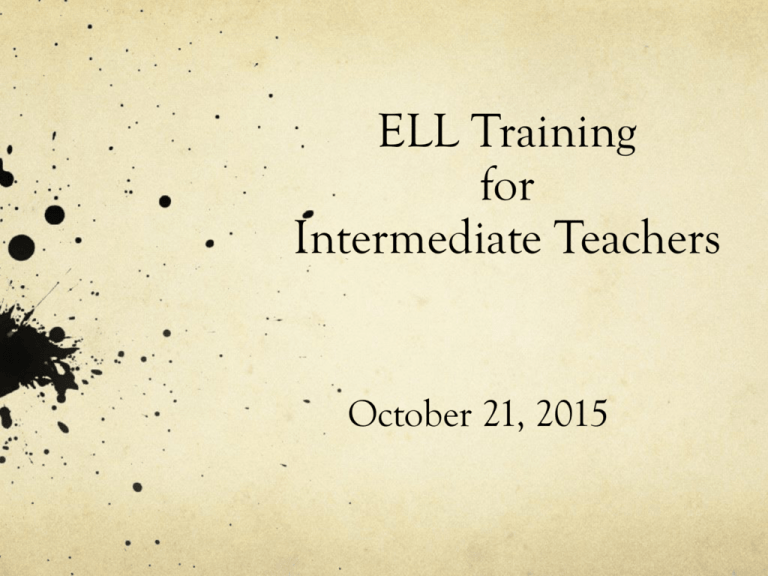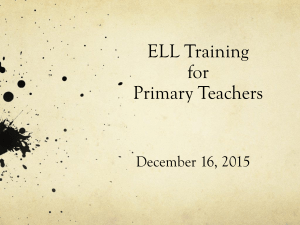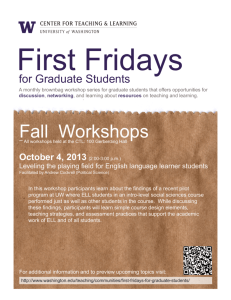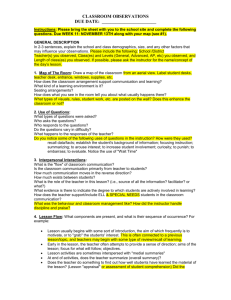Oct. 2015 Training for 3-5 Teachers
advertisement

ELL Training for Intermediate Teachers October 21, 2015 Reflection on Language Learning Experiences Reflect on the questions about your first language and foreign language learning experiences. 1. In what order did you acquire your first 2. 3. 4. 5. language? How was foreign language taught when you were in high school or college? Was it an effective way of learning a new language? What language domain/skill was the hardest to learn? Which language domain/skill was retained over the years? Acquisition vs. Learning Acquisition (case of first language) Learning Subconscious process Conscious process Unaware of grammatical rules Result of direct instruction of rules “Feel” for what is and isn’t correct Language production is not emphasized Emphasis on function, not form More emphasis on form (grammar) Judie Haynes, everthingESL.net Factors that Affect Second Language Acquisition Motivation and attitude Anxiety level Access to the language (e.g. immersion, EFL) Personality and learning style Age and 1st language development Quality of instruction (meaningful and authentic?) Cognitive ability Cultural background Acculturation to the new culture BICS vs.CALP Elementary ELL Student Profiles Island Park: 48 students (19 new / 29 continuing students) West Mercer: 27 students (19 new students / 8 continuing) Lakeridge: 9 students (3 new students / 6 continuing) 16 languages spoken (Mandarin, Korean, Japanese, Cantonese, Russian, Spanish, French, German, Dutch, Portuguese, Hebrew, Vietnamese, Tegulu, Tamil, Malayalam, Icelandic) ELL Program Goals To develop ELL student’s proficiency in English so he/she can participate more fully in the regular classroom setting Help new students adjust to the new school environment (academically, emotionally, socially) Program Model: Supportive Mainstream Students are in mainstream classrooms most of the day ELL teachers provide supplemental English language support (push-in or pull-out) Use of specific strategies to foster English language development and making gradelevel content meaningfully accessible ELL teachers collaborate with classroom teachers Support Time and Delivery Amount of service and delivery of support are determined by: Student proficiency level Grade level Classroom teacher observations/assessments ELL teacher observations/assessments Self assessment by the students Grading & Conferencing If ELL student doesn’t meet grade level standards due to limited English skills, please include a comment. Katie will attend as many parent conferences as her schedule allows Email interpreter request to Kristin Mission of the State TBIP Program English language learners will meet state standards and develop English language proficiency in an environment where language and cultural assets are recognized as valuable resources to learning. Native Language Use “If you talk to a man in a language he understands, that goes to his head. If you talk to him in his language, that goes to his heart .” Nelson Mandela Celebrate Native Language and Culture Many words in English are borrowed from other languages. Can you guess the origin of these words? o Algebra, spinach, cotton, coffee, magazine, sherbet o Essay, table, opinion, family, quarter, bacon, waste o Alphabet, cinnamon, apron, cider, sapphire, aloe o Coconut, zebra, cougar, breeze, junk, embarrass o Canoe, chocolate, tomato, plaza, canyon, patio, coyote o Snack, wagon, bundle, sketch, roster, waffle, dollar Double Challenge ELLs must simultaneously learn how to acquire enough of a second language to participate in an academic setting while gaining an understanding of the knowledge and skills in multiple disciplines through that second language. from Framework for ELP Standards Summary General Strategies for Comprehensible Input Speech appropriate for proficient level Enunciate clearly Slow your speech Take frequent pauses Simplify sentence structure General Strategies for Comprehensible Input Gestures, body language Visuals, graphics, realia Model processes and tasks Demonstrations Hands-on activities Multimedia/technology Chunk information into smaller bits Graphic organizers General Strategies for Comprehensible Input Clear explanations of academic tasks Step-by-step instructions Provide a model or example Think-alouds Match oral directions with written ones Check for comprehension (re-phrasing) General Strategies for Comprehensible Input Use of multiple modes of communication Verbal (give instructions) Visual (show what you mean) Vocal (let students process/talk about it) Color coding to make concepts/directions clear Create flow charts or graphic organizers to conceptualize thinking Challenges as Listeners Requires active processing of the sounds, stresses, intonations, grammar, and meaning of the message being conveyed One of the more difficult demands of learning a new language Listening is used nearly twice as much as speaking, 4-5 times as much as reading and writing Listening is exhausting for newcomers Difficult to listen while trying to copy from the board when words are just symbols, not meaningful Listening Strategies Point out purpose for listening (e.g. listen for main idea, listen for the character’s feeling) Seating arrangement (student facing the front of room) Demonstrate rather than explain Total Physical Response (TPR) - demo Give a copy of the notes afterward so students can focus on listening rather than copying from the board Challenges as Speakers On-demand production of language Sentence structure Limited vocabulary Pronunciation Translation in the head first Oral Language Practice Spoken language and literacy are inextricably linked You cannot write if you don’t have the language to express Oral rehearsal should precede writing on paper Instruction must be interactive and the focus must be on listening and speaking Many opportunities to test the rules of language with scaffolding provided by supportive adults from Mondo’s Let’s Talk About It! and Ballard Tighe’s Strategic Oral Language Instruction in ELD Speaking Strategies Use pair or small group work to increase student talk time (10/2 rule) Consistently give sufficient wait time Provide explicit oral language practice Respect the silent period and know they are taking in language Create a relaxed, non-threatening environment where risk taking is encouraged Teach functional/content language Use sentence frames/starters Don’t overcorrect in speaking and give students the chance to correct themselves Correct promptly for accuracy and afterwards for fluency Model correct grammar; provide correct input in response Chants for Oral Fluency and Concept Reinforcement GLAD chants (Google “pasco chants”) http://www.psd1.org/site/Default.as px?PageID=253 Challenges as Readers Vocabulary deficit Phonics vs. sight words Multiple meanings Fluency vs. comprehension Too many new words make the text impossible Word Knowledge Word knowledge includes mastery of the word’s: Meaning (multiple meanings and connotations) Written form (spelling) Spoken form (pronunciation) Grammatical behavior (occurrences of patterns) Collocations (words that come before or after) Register (formal or informal context) Associations (relation to other words) Frequency (commonly or rarely used) Word Knowledge Rating How well do you know a word? 1. I have never seen the word 2. I have seen the word but don’t know its meaning 3. I know the meaning but can’t explain it well 4. I know the meaning and can articulate it well sophomoric petulance urbane Reading Strategies Use of learner’s dictionaries Merriam-Webster Learner’s Dictionary www.learnersdictionary.com Longman Dictionary of Contemporary English www.ldoceonline.com Translator apps (e.g. Google Translate, Speak and Translate) Memory aids: word cards Vocabulary notebooks Vary the way you explain words Link words grammatically as well as thematically Record words together which occur together Word knowledge indicator cards Challenges as Writers Spelling Writing process (prewriting, draft, revising, editing, and final) Generating own ideas for writing “Writing in your words” or paraphrasing is difficult Show, not tell Different types of writing: narrative, expository (informational), persuasive (opinion), how-to May come from cultures where plagiarism is somewhat acceptable (individual ownership of words or ideas is not well understood, especially info on the internet) Research and scientific writing Different cultures organize essays in different ways Writing Strategies Sentence frames/starters Word bank Oral rehearsal Graphic organizer/mind map Signal words Specific questions to ask for research Interactive writing Cloze sentences/passages Reading aloud of writing for editing Color-coded sentence structure Challenges in Content Areas Math is not a universal language (different symbols, algorithms), story problems, explain answers Science – scientific method, designing/writing up experiments, academic vocabulary, cognitively demanding Social studies – long texts, academic vocabulary, cognitively demanding, context reduced Strategies in Content Areas Math Organize key info through drawing Act out math story problems Science Create charts for each step of scientific method Provide pictures for academic vocabulary Provide copies of teacher’s notes Social Studies Provide pictures for academic vocabulary Paraphrase key points Graphic organizers/flow charts Library Research Resources (with translation/ text-to-speech features) World Book Online Tools > Translate this text Tools > Hear text read aloud eBooks EBSCO (Kids Search and Explora) Choose language > Translate How Can We Support You Monthly workshops focused on different ELL topics K-5 ELL website with students resources and teacher resources Collaboration: planning units of study with grade level teachers iPad apps/support materials Translated books – give two week notice to search and order (if available) Easier non-fiction books in content areas Writing Strategy Brainstorm Scenario: During independent writing, my ELL student doesn’t do anything or just copies instead of producing original work. *What strategies can you use in your class that would support your ELL writer? Use the post-its at your table to record some strategies. Post the notes on the chart.




